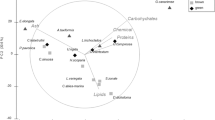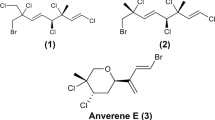Abstract
The first investigation of seaweed chemical defense against herbivores involved the brown seaweed Fucus vesiculosus and suggested defense via phlorotannins. The first demonstration of seaweed induction of secondary metabolites in response to herbivory also involved the genus Fucus and assumed a defensive function for phlorotannins. Many other investigations correlate herbivore feeding preference with changing levels of phlorotannins in this genus and others, but few directly test the effects of phlorotannins. No studies have assessed Fucus chemical defenses using bioassay-guided separation to investigate the complete complement of compounds deterring herbivores. We investigated the deterrence of F. vesiculosus chemical extracts using herbivore bioassays to guide our chemical investigations. Although crude extracts from F. vesiculosus strongly deterred feeding by the sea urchin Arbacia punctulata, phlorotannins from this extract did not deter feeding at 2× or 4× natural concentration by dry mass. Feeding deterrence was due to: (1) a polar galactolipid in the ethyl acetate-soluble extract, and (2) a non-phenolic compound, or compounds, in the water-soluble extract. Although this is the first evidence of galactolipids deterring herbivores, such defenses could be geographically and taxonomically widespread. The galactolipid we discovered in Fucus occurs in marine dinoflagellates, and a related metabolite that deters herbivory has recently been discovered in a tropical green seaweed. We were unable to identify the second deterrent compound, but deterrence occurred in a fraction containing carbohydrates, including sulfated sugars, but no phlorotannins. Given the polarity of these chemical deterrents, they could co-occur with and confound bioassays of phlorotannins if investigators test phlorotannin-containing algal extracts without further purification.


Similar content being viewed by others
References
Appel HM, Govenor HI, D'Ascenzo M, Siska E, Schultz JC (2001) Limitations of Folin assays of foliar phenolics in ecological studies. J Chem Ecol 27:761–778
Boettcher AA, Targett NM (1993) Role of polyphenolic molecular size in reduction of assimilation efficiency in Xiphister mucosus. Ecology 74:891–903
Bolser RC, Hay ME (1996) Are tropical plants better defended? Palatability and defenses of temperate vs. tropical seaweeds. Ecology 77:2269–2286
Bryant JP, Chapin FS, Klein DR (1983) Carbon/nutrient balance of boreal plants in relation to vertebrate herbivory. Oikos 40:357–368
Clausen TP, Provenza FD, Burritt EA, Reichardt PB, Bryant JP (1990) Ecological implications of condensed tannin structure: a case study. J Chem Ecol 16:2381–2392
Coley PD, Bryant JP, Chapin FS (1985) Resource availability and plant antiherbivore defense. Science 230:895–899
Cronin G, Hay ME (1996) Susceptibility to herbivores depends on recent history of both the plant and animal. Ecology 77:1531–1543
Deal MS (1997) The causes and consequences of within-species variation in seaweed chemical defenses. PhD dissertation. University of North Carolina at Chapel Hill, Chapel Hill, N.C.
Denton AB, Chapman ARO (1991) Feeding preferences of gammarid amphipods among four species of Fucus. Mar Biol 109:503–506
Denton AB, Chapman ARO, Markham J (1990) Size-specific concentrations of phlorotannins (anti-herbivore compounds) in three species of Fucus. Mar Ecol Prog Ser 65:103–104
Duffy JE, Hay ME (1994) Herbivore resistance to seaweed chemical defense: the roles of herbivore mobility and predation risk. Ecology 75:1304–1319
Duffy JE, Hay ME (2001) Ecology and evolution of marine consumer-prey interactions. In: Bertness M, Hay ME, Gaines SD (eds) Marine community ecology. Sinauer, Sunderland, Mass., pp 131–157
Duffy JE, Paul VJ (1992) Prey nutritional quality and the effectiveness of chemical defenses against tropical reef fishes. Oecologia 90:333–339
Feeny P (1976) Plant apparency and chemical defense. Recent Adv Phytochem 10:1–40
Fritz RS, Simms EL (eds) (1992) Plant resistance to herbivores and pathogens: ecology, evolution, and genetics. University of Chicago Press, Chicago, Ill.
Geiselman JA, McConnell OJ (1981) Polyphenolics in brown algae Fucus vesiculosus and Ascophyllum nodosum: chemical defenses against the marine herbivorous snail Littorina littorea. J Chem Ecol 7:1115–1133
Glombitza KW, Rosener HU, Koch M (1976) Polyhyudroxyoligophenyle und phenylather aus Bifurcaria bifurcata. Phytochemistry 15:1279–1281
Hay ME, Fenical W (1988) Marine plant-herbivore interactions: the ecology of chemical defense. Annu Rev Ecol Syst 19:111–145
Hay ME, Lee RR, Guieb RA, Bennett MM (1986) Food preference and chemotaxis in the sea urchin Arbacia punctulata. J Exp Mar Biol Ecol 96:147–153
Hay ME, Duffy JE, Pfister CA, Fenical W (1987) Chemical defenses against different marine herbivores: are amphipods insect equivalents? Ecology 68:1567–1580
Hay ME, Renaud PE, Fenical W (1988) Large mobile versus small sedentary herbivores and their resistance to seaweed chemical defenses. Oecologia 75:246–252
Hay ME, Kappel QE, Fenical W (1994) Synergisms in plant defenses against herbivores: interactions of chemistry, calcification, and plant quality. Ecology 75:1714–1726
Hay ME, Stachowicz JJ, Cruz-Rivera E, Bullard S, Deal MS, Lindquist N (1998) Bioassays with marine and freshwater macroorganisms. In: Haynes KF, Millar JG (eds) Methods in chemical ecology, vol 2 (bioassay methods). Kluwer, Norwell, Mass., pp 39–141
Herms DA, Mattson WJ (1992) The dilemma of plants: to grow or defend. Q Rev Biol 67:283–335
Kitagawa I, Hayashi K, Kobayashi M (1989) Heterosigma-glycolipids I and II, the new galactolipids containing octadecatetraenoyl and eicosapentaenoyl residues from a raphidophyte dinoflagellate Heterosigma sp. Chem Pharm Bull (Tokyo) 37:849–851
Koch M, Glombitza KW, Eckhardt G (1980) Phlorotannins of Phaeophycea Laminaria ochroleuca. Phytochemistry 19:1821–1823
Martinez EA (1996) Micropopulation differentiation in phenol content and susceptibility to herbivory in the Chilean kelp Lessonia nigrescens (Phaeophyta, Laminariales). Hydrobiologica 326/327:205–211
McInnes AG, Ragan MA, Smith DG, Walter JA (1985) The high molecular weight polyphloroglucinols of the marine brown alga Fucus vesiculosus L. 1H and 13C nuclear magnetic resonance spectroscopy. Can J Chem 63:304–313
Metsui K, KurishitaS, Hisamitsu A, Kajiwars T (2000) A lipid-hydrolyzing activity involved in hexenal formation. Biochem Soc Trans 28:857–860
Ohlsson LA (2000) Digestion and absorption of galactolipids. In: Christophe AB, De Vriese S (eds) Fat digestion and absorption. AOCS, Champaign, Ill., pp 287–297
Paul VJ, Cruz-Rivera E, Thacker RW (2001) Chemical mediation of macroalgal-herbivore interactions: ecological and evolutionary perspectives. In: McClintock JB, Baker BJ (eds) Marine chemical ecology. CRC, Boca Raton, Fla.,, pp 227–265,
Pavia H, Toth GB (2000) Inducible chemical resistance to herbivory in the brown seaweed Ascophyllum nodosum. Ecology 81:3212–3225
Pavia H, Cervin G, Lindgren A, Aberg P (1997) Effects of UV-B radiation and simulated herbivory on phlorotannins in the brown alga Ascophyllum nodosum. Mar Ecol Prog Ser 157:139–146
Ragan MA (1985) The high molecular weight polyphloroglucinols of the marine brown alga Fucus vesiculosus L.: degradative analysis. Can J Chem 63:294–303
Ragan MA, Craigie JS (1976) Physodes and the phenolic compounds of brown algae. Isolation and characterization of phloroglucinol polymers from Fucus vesiculosus (Linnaeus) Can J Biochem 54:66–73
Ragan MA, Glombitza KW (1986) Phlorotannins, brown algal polyphenols. Prog Phycol Res 4:129–241
Rhoades D, Cates R (1976) Toward a general theory of plant antiherbivore chemistry. Rec Adv Phytochem 10:168–213
Rice WR, Gaines SD (1994) "Heads I win, tails you lose": testing directional alternative hypotheses in ecological and evolutionary research. Trends Ecol Evol 9:235–237
Rosenthal GA, Berenbaum MR (eds) (1992) Herbivores: their interactions with secondary plant metabolites. Academic Press, San Diego, Calif.
Sakata K (1989) Feeding attractants and stimulants for marine gastropods. Bioorg Mar Chem 3:115–127
Sawai Y, Fujita Y, Sakata K, Tamashiro E (1994) 20-Hydroxy-4,8,13,17-tetramethyl-4,8,12,16-eicosatetraenoic acid, a new feeding deterrent against herbivorous gastropods, from the subtropical brown alga Turbinaria ornata. Fish Sci 60:199–201
Schneider CW, Searles RB (1991) Seaweeds of the southeastern United States. Duke University Press, Durham
Schoenwaelder MEA, Clayton MN (1999) The presence of phenolic compounds in isolated cell walls of brown algae. Phycologia 38:161–166
Steinberg PD (1985) Feeding preferences of Tegula funebralis and chemical defenses of marine brown algae. Ecol Monogr 55:333–349
Steinberg PD (1988) The effects of quantitative and qualitative variation in phenolic compounds on feeding in three species of marine invertebrate herbivores. J Exp Mar Biol Ecol 120:221–237
Steinberg PD (1992) Geographical variation in the interaction between marine herbivores and brown algal secondary metabolites. In: Paul VJ (ed) Ecological roles of marine natural products. Comstock Press, New York, pp 51–92
Steinberg PD, van Altena I (1992) Tolerance of marine invertebrate herbivores to brown algal phlorotannins in temperate Australasia. Ecol Monogr 62:189–222
Steinberg PD, Edyvane K, de Nys R, Birdsey R, van Altena IA (1991) Lack of avoidance of phenolic-rich brown algae by tropical herbivorous fishes. Mar Biol 109:335–343
Steinberg PD, Estes JA, Winter FC (1995) Evolutiuonary consequences of food chain length in kelp forest communities. Proc Natl Acad Sci USA 92:8145–8148
Strong DR, Lawton JH, Southwood R (1984) Insects on plants: community patterns and mechanisms. Harvard University Press, Cambridge, Mass.
Targett NM, Arnold TM (1998) Predicting the effects of brown algal phlorotannins on marine herbivores in tropical and temperate oceans. J Phycol 34:195–205
Targett NM, Boettcher AA, Targett TE, Vrolijk NH (1995) Tropical marine herbivore assimilation of phenolic-rich plants. Oecologia 103:170–179
Van Alstyne KL (1988) Herbivore grazing increases polyphenolic defenses in the intertidal brown alga Fucus distichus. Ecology 69:655–663
Van Alstyne KL, Paul VJ (1990) The biogeography of polyphenolic compounds in marine macroalgae: temperate brown algal defenses deter feeding by tropical herbivorous fishes. Oecologia 84:158–163
Van Alstyne KL, Dethier MN, Duggins DO (2001) Spatial patterns in macroalgal chemical defenses. In: McClintock JB, Baker BJ (eds) Marine chemical ecology. CRC Press, Boca Raton, Fla., pp 301–324
Winter FC, Estes JA (1992) Experimental evidence for the effects of polyphenolic compounds from Dictyoneurum californicum Ruprecht (Phaeophyta: Laminariales) on feeding rate and growth in the red abalone Haliotus rufescens Swainson. J Exp Mar Biol Ecol 155:263–277
Yates JL, Peckol P (1993) Effects of nutrient availability and herbivory on polyphenolics in the seaweed Fucus vesiculosus. Ecology 74:1757–1766
Zucker WV (1983) Tannins: does structure determine function? An ecological perspective. Am Nat 120:335–365
Acknowledgements
This work was funded by NSF grants OCE 95–29784 (MEH) and CHE 98–07098 and CHE 01–11270 (WF); additional support was provided by a dissertation fellowship from the UNC-Chapel Hill graduate school to M. S. D. and by the Harry and Linda Teasley endowment to the Georgia Institute of Technology. Comments from Julia Kubanek, Peter Steinberg, and an anonymous reviewer improved the manuscript. Thanks to Phil Levin for providing Fucus from Maine.
Author information
Authors and Affiliations
Corresponding author
Rights and permissions
About this article
Cite this article
Deal, M.S., Hay, M.E., Wilson, D. et al. Galactolipids rather than phlorotannins as herbivore deterrents in the brown seaweed Fucus vesiculosus . Oecologia 136, 107–114 (2003). https://doi.org/10.1007/s00442-003-1242-3
Received:
Accepted:
Published:
Issue Date:
DOI: https://doi.org/10.1007/s00442-003-1242-3




